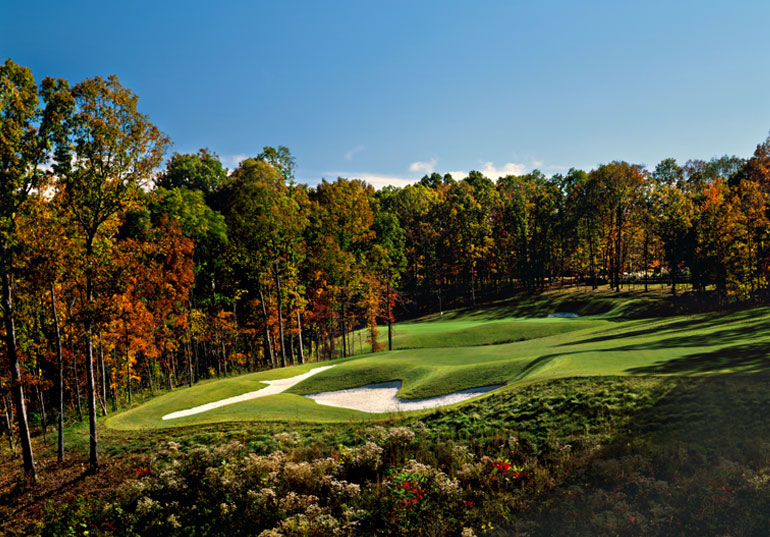The Blessings Golf Club
5826 Clear Creek Blvd
Fayetteville
AR
United States
Home Course: University of Arkansas

Home to the University of Arkansas Men’s and Women’s Golf teams. The Blessings Golf Club is a difficult course with excellent practice facilities.
Located in northwest Arkansas just outside Fayetteville, Blessings Golf Club has earned a reputation as one of the most intellectually demanding courses in collegiate golf. The layout reflects Robert Trent Jones II’s belief that every shot should engage both imagination and precision. From elevated tees that reveal the valley of Clear Creek to greens nestled along natural ridgelines, the course rewards strategy over power. Its dramatic topography and modern training complex have made it a benchmark for NCAA venues, hosting regional championships and the 2019 NCAA Men’s and Women’s Championships. Blessings stands as both a proving ground for elite players and a living example of how thoughtful design can transform a challenging Arkansas landscape into a stage for competition and study.
Golf Course Design by Robert Trent Jones II
Course Design Goals and Challenges
Robert Trent Jones II and owner John Tyson (Chairman and CEO of Tyson Foods) had a number of goals in mind when designing Blessings, near Fayetteville, Arkansas. Mr. Tyson, a very hands-on client, wanted a flexible golf course where every shot required careful thought and precise execution. He also wanted a course sufficiently demanding to host major collegiate tournaments. To meet the dual goals of toughness and flexibility, golf architect Robert Trent Jones II designed a unique golf course with three adjustable holes-eight, nine and sixteen-which can be configured to play to different pars, depending on course setup.
The ability to adjust hole pars gives Blessings an unusual range of setups that test golfers under changing conditions. Jones and Tyson envisioned a course that would sharpen decision-making and highlight the value of shot shaping rather than repetition. The design emphasizes variety through elevation changes, cross-hazards, and bold green contours that require precise short-game control. Each hole presents multiple strategic routes so that coaches and tournament officials can tailor risk and reward for collegiate competition or everyday play. These built-in options extend the course’s life cycle by allowing new experiences with each setup. The result is a living design that continues to challenge players long after they first learn its lines and slopes.
Routing Challenges
Another challenge in designing Blessings was to route the golf course so that the clubhouse could be located outside of the floodplain of Clear Creek, the major topographical and strategic feature of the site. After considering a number of possibilities, we recommended a continuous eighteen-hole routing rather than a pair of returning nines.
Environmental Sensitivity
A third challenge arose as we designed the short, par-three tenth hole, which plays to a green located on an exposed platform at the edge of a vertical rock quarry. The green site was shaded by a grove of hardwoods that we wished to save, but needed to thin out to provide sunlight to the green. To solve this dilemma, we generated computer models that showed sunlight angles to the green at various times of day and season, and figured out how to save the greatest number of trees while allowing for enough light to grow grass on the green. This is a good example of how RTJ II delivers environmentally sensitive solutions to golf course design challenges-something we've been doing for more than 30 years.
Blessings also demonstrates RTJ II’s technical precision in working within complex hydrology. Clear Creek is both the property’s spine and its greatest constraint. To preserve water quality, the design team incorporated vegetated buffer zones and controlled drainage channels that filter runoff before it reaches the creek. Native prairie grasses and hardwood stands were retained to stabilize slopes and create natural framing for key holes. The firm used advanced topographic modeling to ensure that flood-stage water would never disrupt the primary playing surfaces. These measures, combined with the sunlight studies around the quarry green, make Blessings an early example of performance-driven environmental design in American inland golf.
The Blessings Golf Club Course Details
Blessings stretches to nearly 7,500 yards from the back tees and plays through two distinct landforms-the Clear Creek floodplain and a plateau that rises to 65 feet above the floodplain where it’s bisected by a series of ravines. Both the outward and inward nines climb up and down between the two topographies, creating drama and variety on a course where golfers will surely feel both tested and blessed by the glory of their surroundings.
Since opening, Blessings has become a cornerstone of collegiate golf development. Its demanding layout and comprehensive practice grounds provide year-round preparation for student-athletes pursuing professional careers. The partnership between Robert Trent Jones II and John Tyson produced a course that challenges intellect as much as skill, reinforcing the idea that true design excellence lies in creating places that teach as well as test.
Blessings Golf Club — FAQs
Who designed Blessings Golf Club?
Blessings Golf Club was designed by Robert Trent Jones Jr. (RTJ II) in collaboration with owner John Tyson.
Where is Blessings Golf Club located?
Blessings Golf Club is located near Fayetteville, Arkansas, USA.
Which teams call Blessings Golf Club home?
It is the home course of the University of Arkansas Men’s and Women’s Golf teams.
How long is Blessings Golf Club?
Blessings stretches to nearly 7,500 yards from the back tees.
What makes Blessings Golf Club unique?
Three adjustable holes—#8, #9, and #16—can be configured to play to different pars, allowing flexible course setup and heightened strategic variety.
What are the primary landforms the course plays through?
The course plays through the Clear Creek floodplain and a plateau rising about 65 feet above the floodplain, with both nines moving between these settings.
How is the routing laid out?
To keep the clubhouse outside the Clear Creek floodplain and maximize strategy, the course uses a continuous 18-hole routing rather than two returning nines.
How was environmental sensitivity applied to the design?
On the short par-3 10th hole beside a quarry, RTJ II used computer models of sunlight angles to thin hardwoods carefully—preserving trees while ensuring adequate light for healthy turf.
What practice facilities does Blessings offer?
Blessings is known for its excellent practice facilities that support elite collegiate training.


